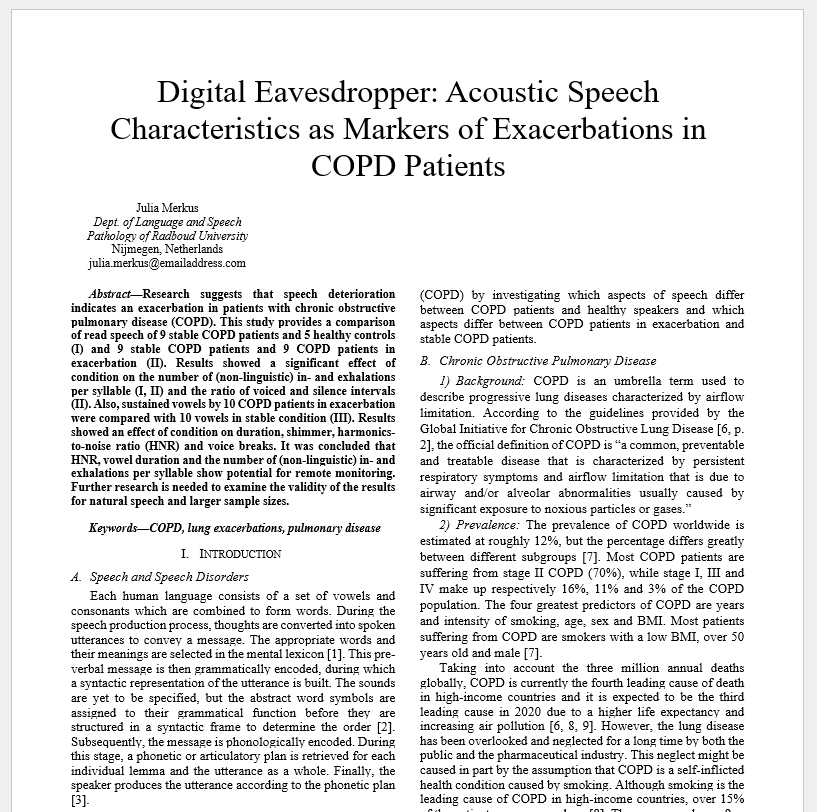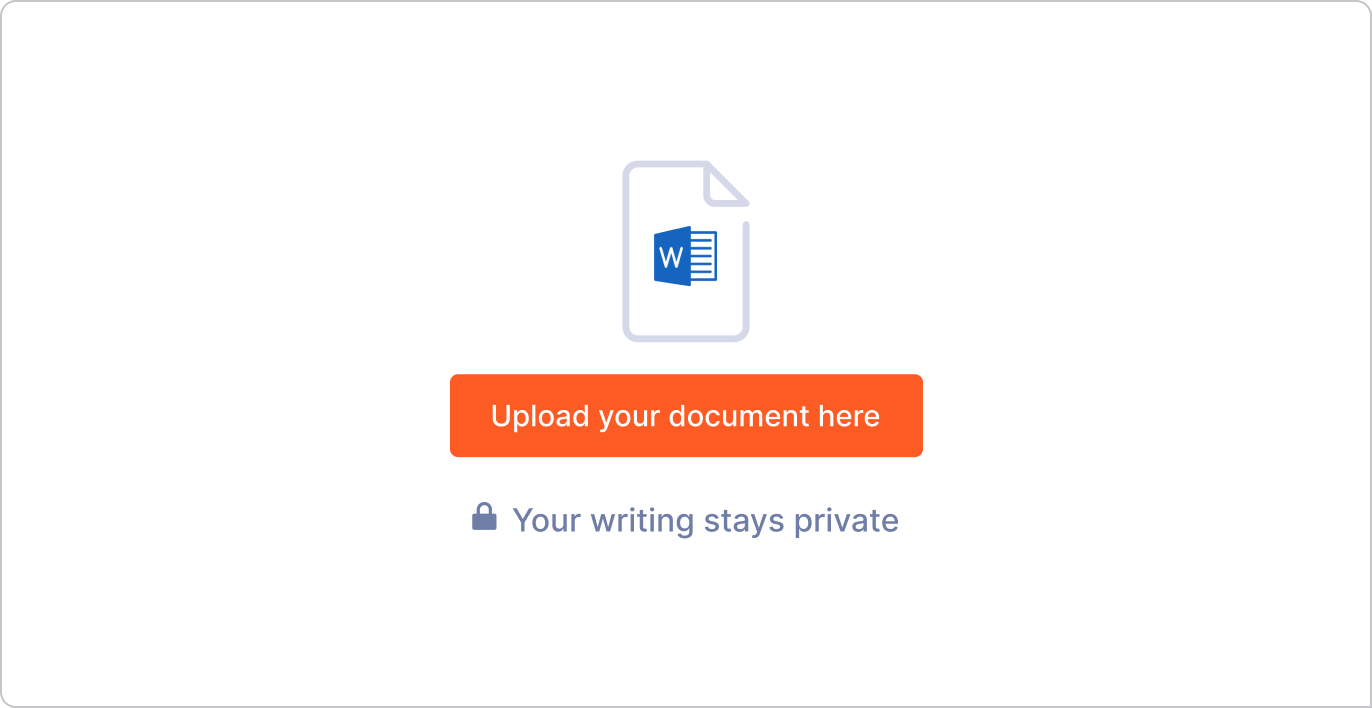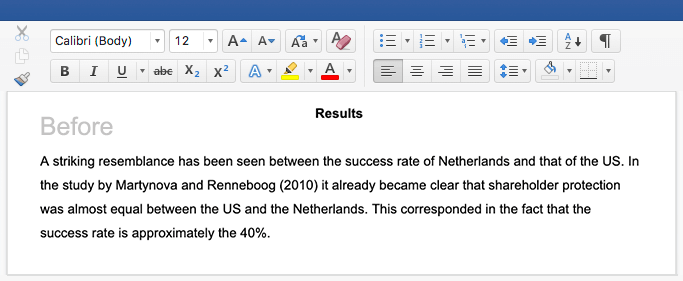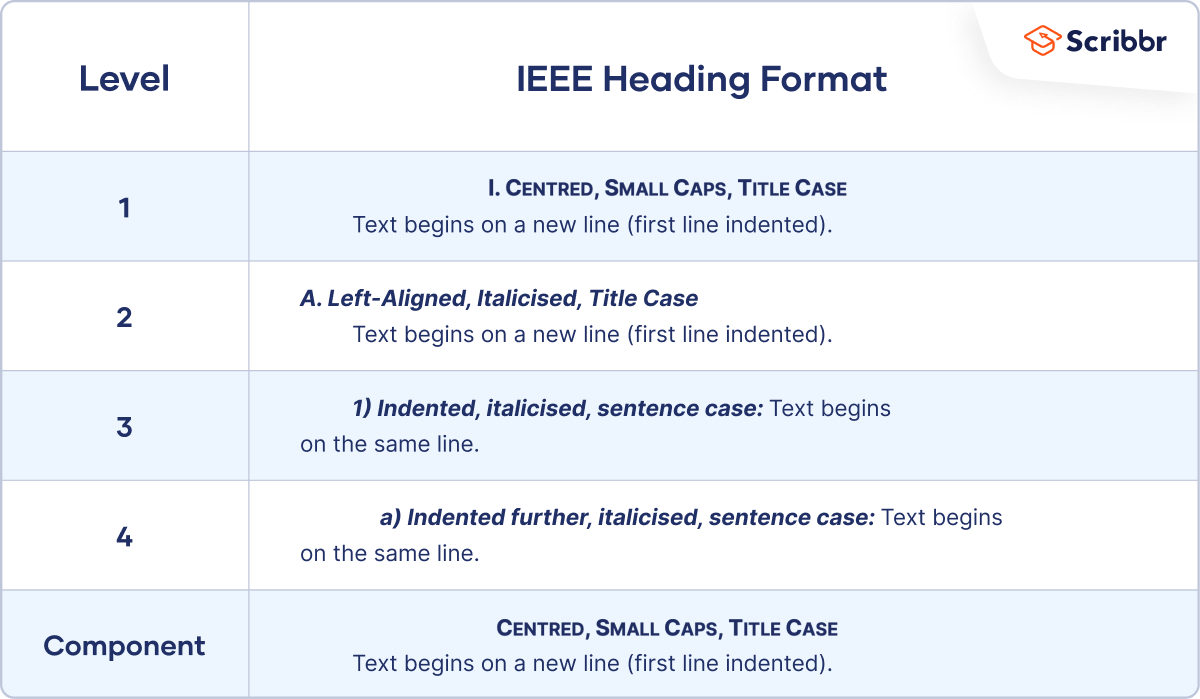Structure Your Article
Learn about the elements that organize a typical IEEE journal article and how to compose your work to help communicate your ideas more clearly.
The article’s title should be specific, concise, and descriptive to help readers decide if they should read the full article. Use keywords and short phrases to describe the article’s content in as few words as possible. Avoid terms such as “new” or “novel” since the reader already knows that your research is new and worthy of publication.
Follow the IEEE authorship guidelines when determining who belongs on the author list.
You may publish your name in your native language, alongside the English version of your name, in the author list if you wish. The guidelines below are for Chinese, Japanese, and Korean characters. All other native language names should be submitted via Unicode characters. In your article’s cover letter, indicate that the article includes author names in native languages.
Be sure to carefully check the rendering of your name in your article during the proof stage before article publication.

Chinese, Japanese, and Korean characters
The following font styles will be used when rendering Chinese, Japanese, or Korean characters in the final publication. Use the appropriate font for your native language to avoid potential errors.
- Simplified Chinese: SongMT
- Traditional Chinese: SungMT
- Japanese: MS Mincho
- Korean: Batang
Use Microsoft Word’s Insert Symbols feature to add the correct characters in parentheses after the name of each author who would like to have their name shown in their native language. Use the standard font listed above to ensure accuracy.
When writing in LaTeX, provide the CJK Ascii Unicode for Chinese (traditional or simplified), Japanese, or Korean.
Your abstract should provide a brief summary of the research conducted, the conclusions reached, and the potential implications of those conclusions.
A strong abstract will also:
- Consist of a single paragraph up to 250 words, with correct grammar and unambiguous terminology
- Be self-contained; without abbreviations, footnotes, references, or mathematical equations
- Highlight what is novel in your work
- Include 3-5 keywords or phrases that describe the research, with any abbreviations clearly defined, to help readers find your article
Most authors write the abstract last and edit it multiple times before article publication to ensure it accurately captures the entire article.
IEEE recommends that you do not include mathematical symbols in your article title or abstract because they may not display properly.
Using the right keywords in your article can make your article more easily and reliably discoverable—which leads to a broader readership for your article. For best results, define any abbreviations and, where possible, strive to use standardized keywords. Using the IEEE Thesaurus can help you find the best standardized keywords to fit your article. Use the thesaurus access request form for free access to the IEEE Thesaurus .
Back to Top
First Footnote
The first footnote is not numbered. All other footnotes in the article are numbered consecutively. Do not use asterisks or daggers. The first footnote (or the author affiliation paragraph) is made up of at least three paragraphs.
First paragraph
The first paragraph consists of:
- all IEEE-provided received, revised, and accepted dates of the article, as well as the two additional online published dates (i.e., first and final publication dates)
- author-provided name(s) of the corresponding author(s) (as well as names of equally contributed authors or co-first authors, if applicable)
- author-provided full financial support for the work in the article (listed here and not in the Acknowledgment)
- author-provided information of full or partial prior presentation of an article (referred to as a “paper”) at a conference, including the DOI of the prior presentation, which links to the conference version and not a preprint; if an article is a thesis or part of a thesis or dissertation, this should be noted in the last sentence of the first paragraph
- Articles That Are Reporting on Human/Animal Research and Have Review Board Approval: This work involved human subjects or animals in its research. Approval of all ethical and experimental procedures and protocols was granted by (Name of Review Board or Committee) (if provided under Application No. xx, and performed in line with the (Name of Specific Declaration (if applicable/provided)).
- Articles That Are Reporting on Human/Animal Research and Are Exempt From Review Board Approval: This work involved human subjects or animals in its research. The author(s) confirm(s) that all human/animal subject research procedures and protocols are exempt from review board approval.
Refer to the IEEE’s policy on Research on Human and Animal Subjects .
Second paragraph
The second paragraph consists of author affiliations, including author-provided department, university or corporation, city, state, province or prefecture (if provided), postal code, and country for each author. Note that the country and corresponding author’s e-mail address must be included. All authors may include their e-mail addresses, which would be separated by semicolons.
See IEEE Editorial Style Manual for Authors for detailed examples of author affiliation types for two or more authors, changed affiliation, retired author, deceased author, and consultant.
Third paragraph
The third paragraph consists of an IEEE-provided notice if the article has supplementary materials and/or color figures in the online version.
Introduction
The introduction section includes a review of the existing literature to position your research within the broader scientific field and to show the novelty of your work. The introduction should also describe the question you’re trying to answer with your research and why that question is important to the field.
Methodology
The methodology section is a straightforward description of what you did in your research and how you did it. A detailed methodology section will make your article reproducible by other researchers, which helps others trust and build upon your work.
Ensure your mathematical equations and formulas display correctly in your published article by following either the IEEE Math Typesetting Guide for LaTeX Users or the IEEE Math Typesetting Guide for MS Word Users .
The results section describes the results you obtained in your research. Include figures and tables as appropriate to illustrate your results. Figures can show data trends or other visual information. Tables are best to use when the exact values are important.
In the discussion section, describe what your results mean and how they are an important contribution to the research field.
The conclusion section can highlight potential broader implications of your work and areas that need further study. Be careful not to inflate your findings.
The reference section is important because all scientific and technical research builds upon previous work. References help give proper credit and attribution to that preceding body of work. References also support and validate your hypothesis. Be sure to only cite references that directly support your work. Inflating citations by adding unnecessary references is considered a breach of publishing ethics.
Acknowledgments
The acknowledgments section is where you can recognize and thank those who have helped you publish this article. Here you can thank your funder, someone who supported you during the research project, or the anonymous reviewers who evaluated the article. The Acknowledgements section is optional but quite common.
Refining the Use of English in Your Article
Communicate your work clearly. If you are not fully proficient in English, consider using an English language editing service before submitting your article. An expert editing service can help you refine the use of English in your article, so you can communicate your work more effectively.
The use of an editing service is paid for by the author. It does not guarantee acceptance in an IEEE publication.
IEEE authors are eligible for discounts at the following language editing services:
- American Journal Experts : 10% discount
- Enago : 30% discount ( review Enago’s services for authors in Chinese )
Purdue Online Writing Lab Purdue OWL® College of Liberal Arts
IEEE General Format

Welcome to the Purdue OWL
This page is brought to you by the OWL at Purdue University. When printing this page, you must include the entire legal notice.
Copyright ©1995-2018 by The Writing Lab & The OWL at Purdue and Purdue University. All rights reserved. This material may not be published, reproduced, broadcast, rewritten, or redistributed without permission. Use of this site constitutes acceptance of our terms and conditions of fair use.
Contained in this page are some basic guidelines for formatting a paper in IEEE style. The best way to format your paper may vary slightly depending on which field you’re working in and the specifics of where your paper is being submitted, so remember to double-check against any submission guidelines provided by the organization, instructor, or supervisor to whom you are submitting your paper.
- The paper title should be centered at the top of the first page, in 24-point type.
- Author’s name (or authors’ names)
- Author affiliation(s)
- City & country location(s)
- E-mail address(es).
- The body of the paper should be in 10-point type, and formatted to appear in two columns. The columns on the last page should be the same length; this may require adding a column break after you have finished the body of your paper.
- All papers must begin with an abstract and index terms.
Note to Practitioners
Nomenclature.
- Acknowledgements
- Papers may be divided into sections and subsections; IEEE has guidelines for primary, secondary, tertiary, and quaternary section headings.
- IEEE papers begin with a drop cap two lines deep, followed by the next 8-12 characters (or 1-2 words, whichever is appropriate) in all caps.
- Figures, tables, and equations should each be numbered consecutively, but separately. They should also be centered in the column in which they appear.
An IEEE abstract should be written as a single paragraph roughly 200 words long, give or take 50 words. (Abstracts shorter than 150 words or longer than 250 risk incurring the irritation of the editors.) It should be self-contained, and should concisely & accurately summarise the contents of your paper. It is encouraged to try and include three or four keywords or key phrases to help interested readers to find your article.
Abstracts should be simply formatted, without anything that requires specialized typesetting or consultation of material outside the abstract. Abbreviations, footnotes, references, tables, graphs, charts, figures, and displayed mathematical equations are specifically forbidden. The goal of an abstract is to be a simple, accessible, and self-contained microcosm of your paper.
Here is an example of how you might format an abstract:
The abstract should be followed by index terms. These should be in a paragraph separate from the abstract. Index terms are similar to keywords and are provided by the paper’s author to help journals, editors, and readers categorize, archive, or locate your paper. IEEE maintains a standardized list of index terms to make this process easier and its categories more consistent. The most recent version of the IEEE Taxonomy can be found on the IEEE website. Here is a link to the 2019 version of the taxonomy .
Index terms should be given in alphabetical order; the first should be capitalized, and the rest lowercase unless they contain acronyms or other components that inherently require capitalization.
Here is an example of how you might format a set of index terms:
Section Headings
Dividing one’s paper into clearly labelled sections increases readability, and is encouraged. Typical sections include Introduction and Conclusion sections as well as sections within the body of the paper that relate to aspects of its content.
Primary headings are enumerated with Roman numerals followed by a period, set in small caps, and centered above the text.
Secondary headings are enumerated with capital letters followed by a period, set in italics and title case, left-aligned, unindented, and separated from the text by a line break.
Tertiary headings are enumerated by Arabic numerals followed by a close-parenthesis, set in italics and title case, left-aligned, indented one em, and separated from the text by a colon. There is no line break between the heading and the text.
Quaternary headings are enumerated by lowercase letters followed by a close-parenthesis, set in italics and sentence case, left-aligned, indented two ems, and separated from the text by a colon. There is also no line break here.
Here is an example of what the various headings should look like in your document:
I. Primary Heading
Lorem ipsum dolor sit amet, consectetur adipiscing elit, sed do eiusmod tempor incididunt ut labore et dolore magna aliqua. Fermentum leo vel orci porta non pulvinar neque laoreet suspendisse.
A. Secondary Heading
Odio ut enim blandit volutpat maecenas volutpat blandit aliquam. Amet consectetur adipiscing elit pellentesque habitant morbi tristique senectus et.
1) Tertiary Heading: Libero justo laoreet sit amet cursus sit. Enim nec dui nunc mattis enim ut tellus elementum sagittis.
a) Quaternary heading: Nibh ipsum consequat nisl vel pretium lectus. Malesuada proin libero nunc consequat interdum varius.
Special Headings
In addition to the standard headings above, there are a few special cases. References and Acknowledgments are formatted like primary headings, but are not enumerated.
Appendix headings should be arranged under a separate system, though formatted like primary headings; if there is only one appendix, it requires neither a number nor a name, but is simply labelled Appendix. If there are multiple appendices, they should be numbered and titled, though one should note that the numbering system for appendix headings is wholly separate from that of section headings; they start at one, regardless of how many sections were present within the paper. Appendices may be enumerated either with Roman numerals or with capital letters, according to the preference of the author, as long as it is done with consistency. Unlike section headings, the number will come after the word “Appendix”: Appendix A rather than A. Appendix. They should have titles, set on the line below them but still formatted like a section heading.
Here is an example of how you might format the beginning of an appendix:
Regarding the Vermiform Process
Lorem ipsum dolor sit amet, consectetur adipiscing elit, sed do eiusmod tempor incididunt ut labore et dolore magna aliqua. At augue eget arcu dictum varius.
If at any point you wish to refer back to a previous section within the text of your paper – e.g. “As mentioned in [section]…” – you should capitalize the word “Section” and separate subsections from the primary section numeral with a hyphen. E.g., “Section IV,” “Section II-A,” “Section III-B4c,” etc.
The Note to Practitioners, if you choose to include one, goes below your abstract. The aim of the Note is to, without repeating any of the information from your abstract, explain the practical applications of your work without use of jargon. This is so that engineers working on practical problems, who may not have significant background in your particular field, will be able to understand the application of your work to theirs.
A Note to Practitioners can be more than one paragraph, but is otherwise formatted like the abstract.
Here is an example of what a Note to Practitioners might look like:
Note to Practitioners – Lorem ipsum dolor sit amet, consectetur adipiscing elit, sed do eiusmod tempor incididunt ut labore et dolore magna aliqua. Enim sit amet venenatis urna cursus eget nunc scelerisque. Feugiat vivamus at augue eget arcu dictum. Lorem donec massa sapien faucibus et molestie. Pellentesque nec nam aliquam sem.
Vel quam elementum pulvinar etiam non quam lacus suspendisse. Velit scelerisque in dictum non consectetur a. Phasellus vestibulum lorem sed risus ultricies tristique nulla. Gravida neque convallis a cras semper auctor. At elementum eu facilisis sed odio morbi quis commodo.
Cursus eget nunc scelerisque viverra mauris in. Fames ac turpis egestas integer eget. Viverra mauris in aliquam sem fringilla ut morbi.
If your paper uses a number of different symbols, variables, and so forth, you may want to avoid having to define them within the body of your paper by providing a list of definitions up front; this is called the Nomenclature section. If you choose to include a Nomenclature section, it goes immediately before the Introduction section.
The heading for the Nomenclature section is formatted like a primary heading with no numeral, and the section itself is formatted generally the same as body text, including the italicization of variables. The main difference is the way in which the text must be aligned: the terms being defined are flush against the left margin, and the definitions are aligned one em-space after the longest defined term.
If you are working in a word processor, the easiest way to do this is often to insert a table into your document with invisible borders below the Nomenclature heading. See the images below for an example. Note that the images have been zoomed in to enlarge the text for clarity purposes.

Example of a nomenclature section

Example of a nomenclature section with the borders of the table used to format the section set to visible
Write Your Paper
IEEE offers guidance to help you write your paper , display equations correctly , improve your graphics , and meet the IEEE Xplore ® Digital Library requirements . Tools and templates will help you as you get your research ready for publication.

Have a language expert improve your writing
Run a free plagiarism check in 10 minutes, automatically generate references for free.
- Knowledge Base
- IEEE Paper Format | Template & Guidelines
IEEE Paper Format | Template & Guidelines
Published on 28 August 2022 by Jack Caulfield . Revised on 6 April 2023.
IEEE provides guidelines for formatting your paper. These guidelines must be followed when you’re submitting a manuscript for publication in an IEEE journal. Some of the key guidelines are:
- Formatting the text as two columns, in Times New Roman, 10 pt
- Including a byline, an abstract , and a set of keywords at the start of the research paper
- Placing any figures, tables, and equations at the top or bottom of a column, not in the middle
- Following the appropriate heading styles for any headings you use
- Including a full list of IEEE references at the end
- Not including page numbers

To learn more about the specifics of IEEE paper format, check out the free template below. Note that you may not need to follow these rules if you’ve only been told to use IEEE citation format for a student paper. But you do need to follow them to submit to IEEE publications.
Instantly correct all language mistakes in your text
Be assured that you'll submit flawless writing. Upload your document to correct all your mistakes.

Table of contents
Ieee format template, ieee heading styles, frequently asked questions about ieee paper format.
The template below can be used to make sure that your paper follows IEEE format. It’s set up with custom Word styles for all the different parts of the text, with the right fonts and formatting and with further explanation of key points.
Make sure to remove all the explanatory text in the template when you insert your own.
Download IEEE paper format template
The only proofreading tool specialized in correcting academic writing
The academic proofreading tool has been trained on 1000s of academic texts and by native English editors. Making it the most accurate and reliable proofreading tool for students.

Correct my document today
IEEE recommends specific heading styles to distinguish the title and different levels of heading in your paper from each other. Styles for each of these are built into the template.
The paper title is written in 24 pt Times New Roman, centred at the top of the first page. Other headings are all written in 10 pt Times New Roman:
- Level 1 text headings begin with a roman numeral followed by a full stop. They are written in small caps, in title case, and centred.
- Level 2 text headings begin with a capital letter followed by a full stop. They are italicised, left-aligned, and written in title case.
- Level 3 text headings begin with a number followed by a closing parenthesis . They are italicised, written in sentence case, and indented like a regular paragraph. The text of the section follows the heading immediately, after a colon .
- Level 4 text headings begin with a lowercase letter followed by a closing parenthesis. They are italicised, written in sentence case, and indented slightly further than a normal paragraph. The text of the section follows the heading immediately, after a colon.
- Component headings are used for the different components of your paper outside of the main text, such as the acknowledgments and references. They are written in small caps, in title case, centred, and without any numbering.

You should use 10 pt. Times New Roman font in your IEEE format paper .
For the paper title, 26 pt. Times New Roman is used. For some other paper elements like table footnotes, the font can be slightly smaller. All the correct stylings are available in our free IEEE format template .
No, page numbers are not included in an IEEE format paper . If you’re submitting to an IEEE publication, page numbers will be added in the final publication but aren’t needed in the manuscript.
IEEE paper format requires you to include an abstract summarising the content of your paper. It appears at the start of the paper, right after you list your name and affiliation.
The abstract begins with the word ‘Abstract,’ italicised and followed by an em dash. The abstract itself follows immediately on the same line. The entire section is written in bold font. For example: ‘ Abstract —This paper discusses …’
You can find the correct format for your IEEE abstract and other parts of the paper in our free IEEE paper format template .
Cite this Scribbr article
If you want to cite this source, you can copy and paste the citation or click the ‘Cite this Scribbr article’ button to automatically add the citation to our free Reference Generator.
Caulfield, J. (2023, April 06). IEEE Paper Format | Template & Guidelines. Scribbr. Retrieved 21 May 2024, from https://www.scribbr.co.uk/ieee-referencing/ieee-format-paper/
Is this article helpful?

Jack Caulfield
Other students also liked, ieee reference page | example & format, vancouver referencing | a quick guide & reference examples.
The IEEE is pleased to provide comprehensive LaTeX support to it's authors and members in partnership with Overleaf.
Overleaf is an online LaTeX and Rich Text collaborative writing and publishing tool that makes the whole process of writing, editing and producing scientific documents much quicker and easier for both authors and publishers.
Discover the Overleaf editor
Additional Resources
- A free online Introduction to LaTeX course is provided by Dr John Lees-Miller of Overleaf.
- A selection of IEEE templates are provided below. These are pre-loaded into Overleaf for immediate use.
- The IEEE Author Digital Toolbox , which includes a graphics checker tool and IEEE reference preparation assistant.
IEEE Official Templates

IEEE Community Templates

Get in touch
Have you checked our knowledge base ?
Message sent! Our team will review it and reply by email.
Email:
Paper Review Samples
Ieee account.
- Change Username/Password
- Update Address
Purchase Details
- Payment Options
- Order History
- View Purchased Documents
Profile Information
- Communications Preferences
- Profession and Education
- Technical Interests
- US & Canada: +1 800 678 4333
- Worldwide: +1 732 981 0060
- Contact & Support
- About IEEE Xplore
- Accessibility
- Terms of Use
- Nondiscrimination Policy
- Privacy & Opting Out of Cookies
A not-for-profit organization, IEEE is the world's largest technical professional organization dedicated to advancing technology for the benefit of humanity. © Copyright 2024 IEEE - All rights reserved. Use of this web site signifies your agreement to the terms and conditions.

IMAGES
VIDEO
COMMENTS
IEEE provides guidelines for formatting your paper. These guidelines must be followed when you're submitting a manuscript for publication in an IEEE journal. Some of the key guidelines are: Formatting the text as two columns, in Times New Roman, 10 pt. Including a byline, an abstract, and a set of keywords at the start of the research paper.
The purpose of a conference template is to provide a consistent format for papers appearing in the conference proceedings. IEEE strongly encourages use of the conference manuscript templates provided below. IEEE conference templates contain guidance text for composing and formatting conference papers. Please ensure that all guidance text is ...
mean. In your paper title, if the words "that uses" can accurately replace the word using, capitalize the "u"; if not, keep using lower-cased. Be aware of the different meanings of the homophones "affect" and "effect," "complement" and "compliment," "discreet" and "discrete," "principal" and "principle.".
IEEE article templates let you quickly format your article and prepare a draft for peer review. Templates help with the placement of specific elements, such as the author list. They also provide guidance on stylistic elements such as abbreviations and acronyms. Use the interactive IEEE Template Selector to find the template you need by ...
Select Format. Download Template. Find the right IEEE article template for your target publication. Please select your publication type below. Transactions, Journals and Letters. Magazines. Conferences. Use the IEEE Publication Recommender if you don't know where you want to publish.
Refer to the IEEE's policy on Research on Human and Animal Subjects. Introduction. Help the reader understand why your research is important and what it is contributing to the field. Start by giving the reader a brief overview of the current state of research in your subject area. Progress to more detailed information on the specific topic of ...
B. Style. Reference numbers are set flush left and form a column of their own, hanging out beyond the body of the reference. The reference numbers are on the line, enclosed in square brackets. In all references, the given name of the author or editor is abbreviated to the initial only and precedes the last name.
Write. Use IEEE conference templates in Word or LaTeX to easily format your paper for publication. Write collaboratively with your co-authors in Overleaf, an authoring tool for LaTeX and rich text documents. Overleaf is preloaded with IEEE templates for your convenience. Overleaf and LaTeX resources are available online for both beginners and ...
Highlight what is novel in your work. Include 3-5 keywords or phrases that describe the research, with any abbreviations clearly defined, to help readers find your article. Most authors write the abstract last and edit it multiple times before article publication to ensure it accurately captures the entire article.
The paper title should be centered at the top of the first page, in 24-point type. The byline should be centered below the title, after a line break, in 10-point type. It should contain the following, on separate lines: E-mail address (es). The body of the paper should be in 10-point type, and formatted to appear in two columns.
and related fields. ieee journals are cited over three times more often in patent applications than other leading publishers' journals [1]. as an ieee author, you will both contribute to and benefit from that impact and reputation. authors need to find your research in order to cite it. The EEE i Xplore digital library is an
Write Your Paper. IEEE offers guidance to help you write your paper, display equations correctly, improve your graphics, and meet the IEEE Xplore ® Digital Library requirements . Tools and templates will help you as you get your research ready for publication. IEEE offers guidance, tools, and resources to help you write your paper, display ...
These instructions give you guidelines for preparing papers for IEEE Transactions and Journals. Use this document as a template if you are using Microsoft Word 6.0 or later. Otherwise, use this document as an instruction set. The electronic file of your paper will be formatted further at IEEE. Do not cite references in the abstract. Do not delete the blank line immediately above the abstract.
US Letter-sized paper: side = 0.625 inch; top = 0.75 inch; bottom = 1 inch; ... IEEE Conferences and Custom Publishing, 18-Jul-2002 3:59 PM . Glossary of Terms for the Conference Manuscript Format Definition Table 1 em Length equal to the width of uppercase M in a particular font + font size. Example: 1 em in 10 point Times New Roman is ...
IEEE provides guidelines for formatting your paper. These guidelines must be followed when you're submitting a manuscript for publication in an IEEE journal. Some of the key guidelines are: Formatting the text as two columns, in Times New Roman, 10 pt. Including a byline, an abstract, and a set of keywords at the start of the research paper.
First Author#, Second Author*, Third Author#. Abstract— This document gives formatting instructions for authors preparing papers for publication in the Proceedings of an IEEE conference. The authors must follow the instructions given in the document for the papers to be published. You can use this document as both an instruction set and as a ...
The IEEE provides guidelines for the preparation of papers and presentations for their conference proceedings, including a series of LaTeX templates. A number of templates using the IEEE style are available on Overleaf to help you get started - click above to use this template for Computer Science journals, or use the tags below to find more.
The well-written scientific paper has two essential ingredients: organization and appropriate language within that organization. The component parts of a scientific paper are reviewed: Title, Abstract, Introduction, Materials and Methods, Results, Discussion, Acknowledgment, and Literature Cited; and, with quoted material, inappropriate language use is illustrated.
IEEE Transactions, if the issue number or month is not available, research IEEEXplore to update the information. For any ... Basic Format: J. K. Author, "Title of paper," presented at the Abbreviated Name of Conf., City of Conf., Abbrev. State, Country, ... IEEE Summer Power Meeting, Dallas, TX, USA, Jun. 22-27, 1990, Paper 90 SM 690-0 ...
Date Added to IEEE Xplore: 30 November 2021 ISBN Information: Electronic ISBN: 978-1-6654-4905-2 Print on Demand(PoD) ISBN: 978-1-6654-4906-9 INSPEC Accession Number: ... Short Research Papers Abstract: Start of the above-titled section of the conference proceedings record.
IEEE Xplore, delivering full text access to the world's highest quality technical literature in engineering and ... Paper Review Samples Published in: 2022 IEEE 5th International Conference on Image Processing Applications and Systems (IPAS) Article #: Date of Conference: 05-07 December 2022 Date Added to IEEE Xplore: 28 February 2023 ...